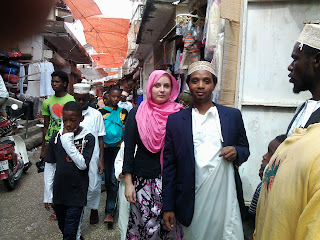Most of
our time in Nairobi went just for getting used to it. We saw some
very interesting things, such as a photo exhibition called Kenya
Burning, portraying the last election riots. Here's the webiste of the exhibition. It was very thought provoking and surprisingly
honest, being in a state owned gallery space.
 | |
| Tall buildings in downtown Nairobi |
 | |
| Street view of Nairobi |
From Nairobi we took a bus to Mombasa.
The company people recommended for us was called ”Coast Air”,
even though it was a bus. They promised AC, internet and a luxury
bus, so we were ok with paying a bit more than the other companies
would take. Unfortunately, this is NOT what we got.
Internet didn't work. Half of the
journey the toilet was out of use. Air-con didn't work either. Worst of
all, they kept playing same comedy shows and musics very, VERY loud the
whole way. The trip was said to take around 6 hours, truth was that
it took 8. This, unfortunately, is very usual.
In Mombasa we headed to a hotel in the
city center. This was a grave mistake. The city center is busy,
noisy, and has next to nothing to see or enjoy. A walk in the Old
Town was a spooky experience – after being used to Stone Town, it
felt like a ghost town, or an open-air museum. There were people
living there, but no hotels, no restaurants, and all the shops were
closed in the evening time.
 | |
| Fort Jesus in Mombasa |
 | |
| Example of an interesting building in the Old Town of Mombasa |
But we needed to head to the beach to
get a look at it.
First we visited Bamburi beach, and did
find one nice hotel to stay in. It's just that at that time, we didn't
appreciate it enough and decided not to stay there. But after that,
we saw what else Bamburi beach had to offer – and we were not too
impressed! Depressing, badly planned hotels with ridiculous prices,
one after another after another...
We ended up staying in Nyali beach. Not
in the beach – it was full of big, big resorts. We stayed a bit
behind the beach in a reasonably priced apartment hotel, which
actually made us quite happy.
All in all, Mombasa was not the
paradise I was expecting it to be. And I left it with a strong
feeling that maybe there was more to it, maybe we didn't find the
best spots after all. I truly hope so – or I feel sorry for the
travelers who waste their money to be in these crowded hotels on this
not-so-amazing beach.










